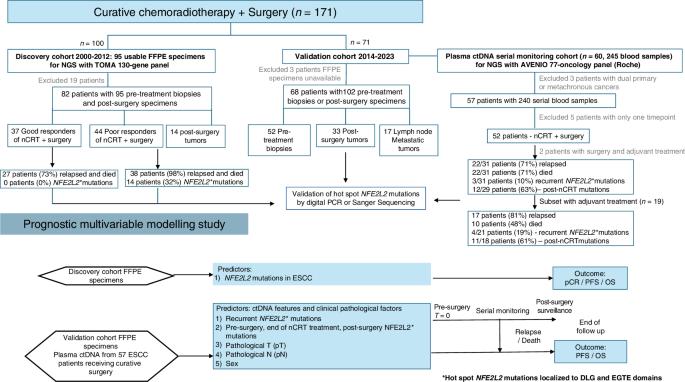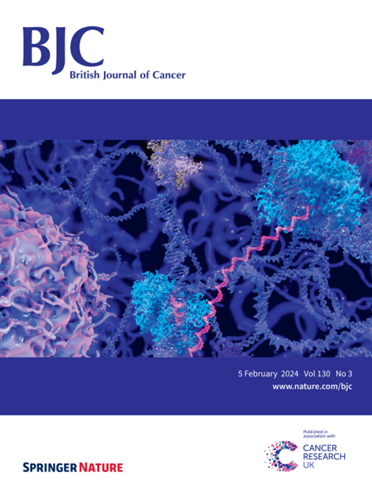Oncogenic NFE2L2 mutations in plasma ctDNA and tumors are predictors and prognosticators of chemoradiation therapy in resectable esophageal squamous cell carcinoma
IF 6.8
1区 医学
Q1 ONCOLOGY
引用次数: 0
Abstract
The poor prognosis of resectable esophageal squamous cell carcinoma (ESCC) poses an unmet need to identify early predictive and prognostic genomic biomarkers to improve treatment outcome and risk stratification. Mutational profiling was performed for 171 ESCC patients receiving curative neoadjuvant chemoradiation treatment (nCRT). The discovery cohort included 100 ESCC formalin-fixed paraffin-embedded (FFPE) tumor specimens; the validation FFPE cohort consisted of serial ctDNA samples from 71 patients. The discovery cohort identified hot-spot oncogenic NFE2L2 mutations exclusively localized at DLG and ETGE KEAP1-binding motifs in poor responders associated with incomplete pathological response (P = 0.004). Patients with NFE2L2 mutations in two independent FFPE cohorts had about 2-fold higher risk of death and recurrence. Serial ctDNA analysis further demonstrated oncogenic NFE2L2 mutations detected at post-nCRT were independent prognosticators for recurrence (HR = 5.90; P = 0.005) and survival (HR = 4.75; P = 0.013). Risk stratification based on pathological T and N stages, positive FFPE (HR = 4.50) and ctDNA NFE2L2 mutations (HR = 8.50) identified high-risk groups for recurrence (P = 0.001). Combined FFPE and ctDNA NFE2L2 mutation status predicted nCRT responses (P = 0.05) by ROC analysis. Tracking oncogenic NFE2L2 mutations at pre-treatment and post-surgery or serial ctDNA monitoring during treatment are useful nCRT predictors and independent prognosticators of survival for locally advanced ESCC.

血浆ctDNA和肿瘤中致癌的NFE2L2突变是可切除食管鳞状细胞癌放化疗的预测因素和预后因素。
背景:可切除食管鳞状细胞癌(ESCC)预后不良,因此需要识别早期预测和预后的基因组生物标志物,以改善治疗结果和风险分层。方法:对171例接受根治性新辅助放化疗(nCRT)的ESCC患者进行突变分析。发现队列包括100例ESCC福尔马林固定石蜡包埋(FFPE)肿瘤标本;验证FFPE队列包括来自71例患者的连续ctDNA样本。结果:发现队列在与不完全病理反应相关的不良应答者中发现了仅定位于DLG和ETGE keap1结合基元的热点致癌NFE2L2突变(P = 0.004)。在两个独立的FFPE队列中,NFE2L2突变患者的死亡和复发风险高出约2倍。序列ctDNA分析进一步表明,ncrt后检测到的致癌NFE2L2突变是复发的独立预测因素(HR = 5.90;P = 0.005)和生存率(HR = 4.75;p = 0.013)。基于病理T和N分期、阳性FFPE (HR = 4.50)和ctDNA NFE2L2突变(HR = 8.50)的风险分层确定了复发的高危人群(P = 0.001)。联合FFPE和ctDNA NFE2L2突变状态预测nCRT疗效(P = 0.05)。结论:在治疗前和手术后追踪致癌的NFE2L2突变或在治疗期间连续监测ctDNA是有用的nCRT预测指标和局部晚期ESCC生存的独立预测指标。
本文章由计算机程序翻译,如有差异,请以英文原文为准。
求助全文
约1分钟内获得全文
求助全文
来源期刊

British Journal of Cancer
医学-肿瘤学
CiteScore
15.10
自引率
1.10%
发文量
383
审稿时长
6 months
期刊介绍:
The British Journal of Cancer is one of the most-cited general cancer journals, publishing significant advances in translational and clinical cancer research.It also publishes high-quality reviews and thought-provoking comment on all aspects of cancer prevention,diagnosis and treatment.
 求助内容:
求助内容: 应助结果提醒方式:
应助结果提醒方式:


